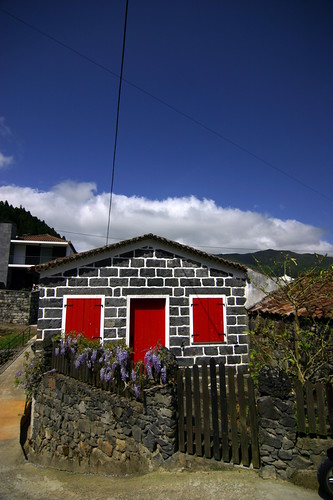Fajãs
Originating in the collapse of cliffs, the fajãs are flat areas that stretch along the coast. All of them have been converted into fertile orchards, into fields where yams, maize and vegetables are grown. Due to micro-climates, it is possible to grow coffee, vineyards, tropical fruits and beautiful dragon trees in some of them. There are fajãs on both sides of the island. On the lower, sunnier southern coast, you will find the fajãs of Velas, Santo Amaro, Almas, Grande, Vimes, Bodes, Além, São João, Cardoso and Alabaçal. The north is a succession of tiny fajãs at the bottom of ravines that are hundreds of metres deep; the outstanding ones are those of Caldeira de Santo Cristo (with an underwater cave and a lake from which delicious cockles are obtained - the only ones in the Azores), Cubres (also with a crystalline lake) and Ouvidor (the limiting rocks of which have been made lace-like by the ocean).
The central peaks
An area that corresponds to the most recent part of the island which is geologically the product of three important volcanic eruptions spaced out ever thousands of years, of which the "welding" can be seen in the fractures that interrupt the landscape to the east and to the west. It is made up of small volcanic cones of which the highest - Pico da Esperança, with an altitude of 1,067 metres - offers views that take in the nearest islands: Faial, Pico, Graciosa and Terceira.
The Islets
Slightly to the north of the picturesque parish of Topo lies a verdant islet where cattle graze, brought to and from the pastures by boat. Off the western tip of the island lies Rosais islet, an inhospitable rock inhabited only by sea-birds.
The natural arches
The waves have hollowed out the hard lava, creating natural bridges and arches along the coast. The most interesting are situated at Velas and.in the fajã of Santo Amaro.
Grottoes
Walking along the coast near Urzelina, you can reach Furna das Pombas, a curious volcanic formation inhabited by wild pigeons. Algar do Montoso, situated on the peak of the same name, requires experience and equipment.
Streams
They begin as tricles of water. But they soon gain momentum and when they reach the cleavage lines of the crest of the island they often turn into striking waterfalls that leap tens or hundreds of metres until they reach the sea.
Parks
Sete Fontes in the Parish of Rosais and Silveira at Ribeira Seca display the most beautiful things nature can offer in the spring and summer.





1 comment:
Great post... it makes me remember the great vacations that I had there... next year I will be back... :o) Maybe I will see you there...
Post a Comment